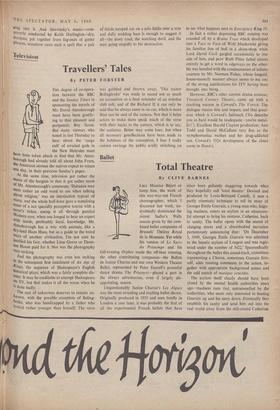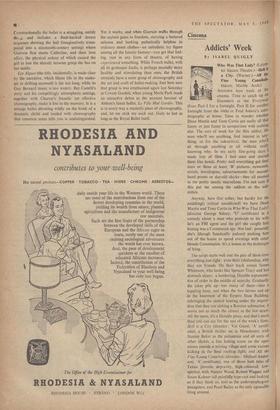Ballet
Total Theatre
By CLIVE BARNES Unquestionably Janine Charrat's Les Algues was the most revealing and exciting ballet shown. Originally produced in 1953 and seen briefly in London a year later, it was probably the first of all the experimental French ballets that have since been gallantly staggering towards what they hopefully call 'total theatre.' Devised and produced by Louis-Bertrand Castelli, it uses a partly cinematic technique to tell its story of Georges Emile Guerain, a young man who, feign- ing madness, enters an asylum in an unsuccess- ful attempt to bring his mistress, Catherine, back to sanity. The ballet opens with the sound of clanging doors and a disembodied narration portentously announcing that: 'On December 3, 1949, Georges Emile Guerain was admitted to the lunatic asylum of Longeat and was regis- tered under the number of 3422.' Spasmodically throughout the ballet this sound-track, sometimes representing a Chorus, sometimes Guerain him- self, adds running comments to the action, to- gether with appropriate background noises and the odd snatch of musique concrete.
The asylum itself clearly should have been closed by the mental health authorities years ago—madness runs riot, untrammelled by the authorities, who seem only interested in beating Guerain up and his story down. Eventually they establish his sanity and send him out into the real world away from the still-crazed Catherine.
Constructionally the ballet is a straggling, untidy and includes a flash-backed dream sequence showing the ball (imaginatively trans- posed into a nineteenth-century setting) where Guerain first meets Catherine, and their love affair, the physical ardour of which caused the girl to lose the already tenuous grasp she has on her sanity.
Les Algues (the title, incidentally, is made clear by the narrative, which likens life in the snake- pit to drifting seaweed) is far too long, while its Guy Bernard music is itoo watery. But CasteIli's story and his compellingly atmospheric settings, together with Charrat's frenetic yet effective choreography, make it live in the memory. It is a strange ballet shivering wildly on the brink of a dramatic cliché and loaded with choreography that common sense tells you is undistinguished.
Yet it works, and when Guerain walks through the asylum gates to freedom, carrying a battered suitcase and looking pathetically helpless in ordinary street clothes—an unballetic lay figure among all the lunatic fantasy—you get that feel- ing, rare in any form of theatre, of having experienced something. While French ballet, with all its grotesque faults, is perhaps mentally more healthy and stimulating than ours, the British certainly have a surer grasp of choreography and the art and craft of ballet-making. Just how sure that grasp is was emphasised again last Saturday at Covent Garden, when young Merle Park made an attractive debut as the peasant heroine of Ashton's latest ballet, Le Fine Mal Gardee. This is in every way a masterly piece of choreography, and, let me stick my neck out, likely to last as long as the Royal Ballet itself.







































 Previous page
Previous page